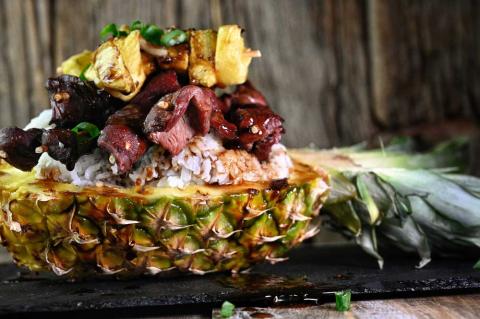Ryan Graves
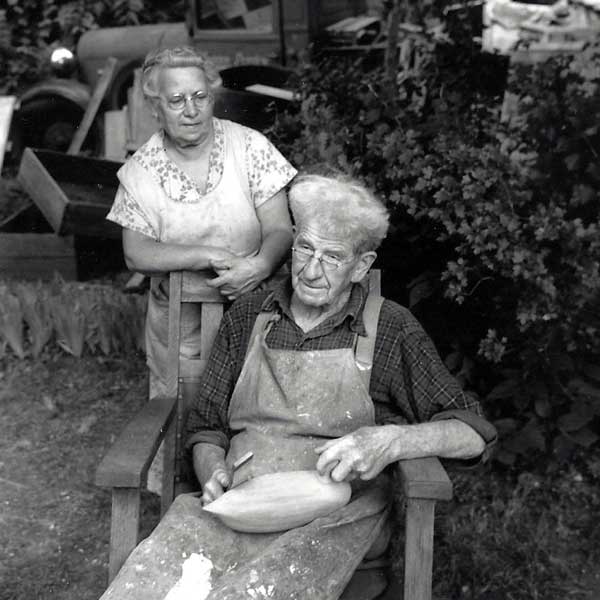
Henry, Illinois
1874-1963
No other name associated with vintage sporting collectibles is as recognizable as the name, Charles Perdew. Although he is probably best known for his decoy making, he was also a very accomplished duck call maker which is what we will focus on in this article.
Charles Perdew was born to Moses and Nancy Perdew on April 30th, 1874 in Oxbow Prairie, a small community in Putnam County, Illinois just a few miles north of Henry. Perdew grew up and worked on the family farm on Dutchman’s Hill. At the bottom of the hill sat Saw Mill Lake, a famous waterfowling lake along the Illinois River. As a young man, Perdew began to enjoy the hunting and fishing opportunities that the river offered. Perdew was a hard worker. He and his brothers built a cabin on the lake to house sports when they came to hunt. It is said that Charlie first made decoys and calls for himself to use during this time. No other name associated with vintage sporting collectibles is as recognizable as the name Charles Perdew. Although he is probably best known for his decoy making, he was also a very accomplished duck call maker which is what we will focus on in this article.
Charles Perdew was born to Moses and Nancy Perdew on April 30, 1874 in Oxbow Prairie, a small community in Putnam County, Illinois, just a few miles north of Henry. Perdew grew up and worked on the family farm on Dutchman’s Hill. At the bottom of the hill sat Saw Mill Lake, a famous waterfowling lake along the Illinois River.

In 1889, at the age of 15, Perdew left the family farm and went to Chicago to work in the meatpacking market. He stayed in Chicago for six years before returning to the Putnam area to get away from the big city life. Upon returning, Perdew went to work as a carpenter and did many odd jobs.
Around 1900, Perdew opened a workshop in downtown Henry where he sold and worked on guns, built boats, made signs, decoys, duck, and crow calls. Along the way, he met a young lady in Henry by the name of Edna Haddon. She was an experienced painter and helped him out with painting jobs. Their relationship went from business to personal and in 1902, they got married on Thanksgiving day.

Like many call makers from the Illinois River valley, it appears that Perdew’s call making was influenced by Charles Grubbs, whom I previously wrote an article on. Perdew’s earliest duck call was made of cedar and marketed as the “Original Illinois River Duck Call.” If you will remember, Grubbs also marketed his calls as “Illinois River Model” and “Improved Illinois River Model.” There was obviously a connection between the two. It was previously thought that Perdew’s call making efforts started in the early 1900s, but I was able to find an example that has “1898” scratched into the metal band on the barrel.
Perdew made three models of duck calls: a red cedar Illinois River model, a black walnut St. Francis River model, and a fancy carved model made out of mahogany. Perdew sold his calls locally and through Von Lengerke and Antoine, an upscale sporting goods store that was located on Wabash Avenue in Chicago.
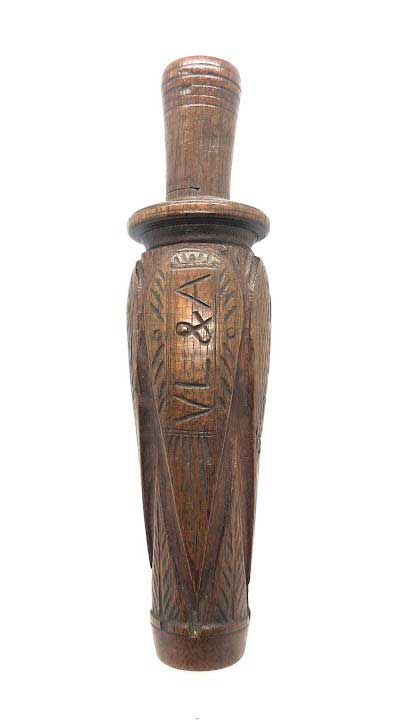
owned by Budd Parr, charter member of the Chicago
Meredosia Duck Club.
The cedar Illinois River model that he sold is often referred to as Perdew’s “standard model” by collectors. His earliest examples of these calls had no rings turned into the stopper nor did they have Perdew’s name stamped into the barrel. Perdew added German silver bands to his call to strengthen the barrel to keep it from splitting. The bands also added to the overall look of the call.
A few years into his callmaking, Charles began stamping his call with his name and city. Some early examples have the letters “Mfg,” for manufactured stamped in front of his name. The stamp would read “MFG by C.H. Perdew Henry Ill”. The most common stamped Perdew that you will find has “Chas H. Perdew Henry Ill.”
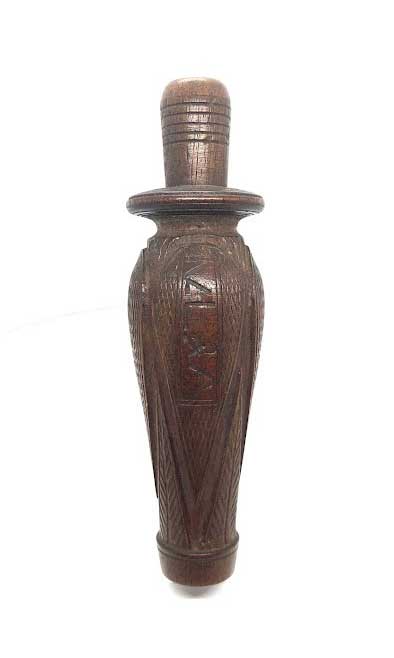
Notice the differences from the above early example
made by Perdew.
Perdew’s second style of call design is referred to as the “St. Francis River Style” call. The St. Francis River begins in southeast Missouri and flows south through Arkansas. Although it cannot be proven, the origin of this model most likely began with J.T. Beckhart.
This design was initially made for the distribution through VL&A in Chicago. Thoughts by many knowledgeable collectors is that VL&A company reached out to Beckhart to make a call that they could sell and market. The earliest St. Francis River model calls with “VL&A” carved into them clearly were not the work of Perdew. The overall quality of the call is far superior to that of the VL&A models that we know that Perdew made. Other differences are the early models have four finely checkered panels whereas the later models made by Perdew only have three.
Instead of having a checkered panel around the VL&A initials, Perdew carved lines that resemble a “sunburst” pattern. Another key difference is that the “VL&A” letters are carved into the panels opposite of the way that Perdew carved them. That means that the earlier maker of the calls was the opposite hand of Perdew.
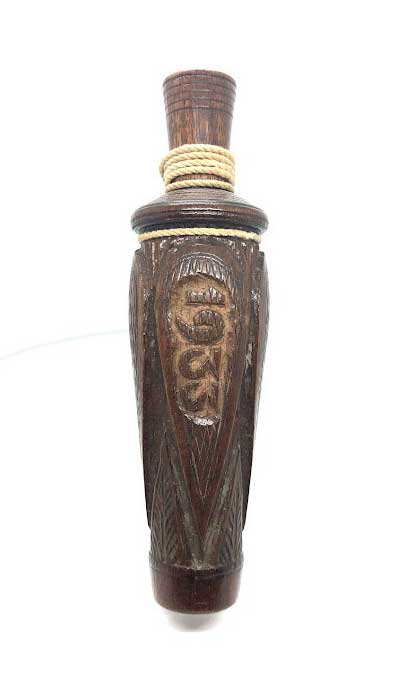
example of Perdew carving a date
There are very few examples of this early style of VL&A call. It is believed that Beckhart started making them but simply was unable to keep up with the demand and logistics of getting the calls to Chicago. Perdew, who was much closer to Chicago, was able to fill their demand and later got the nod to make them. VL&A sold the calls for $2.50. If a hunter wanted one of these calls, they could also buy them directly from Perdew and he would put their initials in them instead of VL&A.
The third style of call that Perdew made was his carved model. This was his high-end model that he began making in the 1920s and was only available for purchase directly through him. The carved calls shared the same shape and look of the St. Francis River model but were made out of mahogany and had ducks carved into the panels along with the owners initials.
Except for some early examples that had two carved ducks, the vast majority had three ducks, two drakes and a hen carved into the relief panels, all with tiny glass eyes, and painted to match his decoys by his wife, Edna. Perdew also added bakelite mouthpieces to his custom carved calls as well.
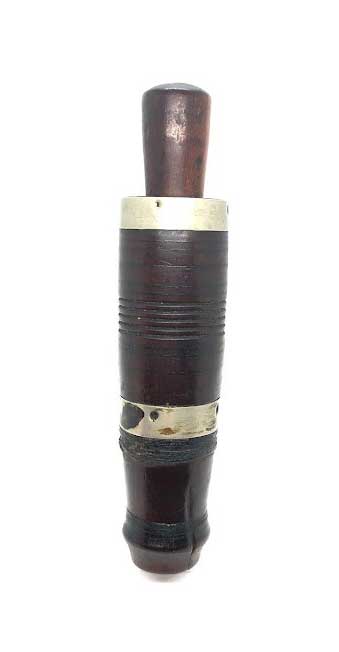
Has “1898” carved in the top metal band.
He used three different colors of mouthpieces. The earliest color used by Perdew for his mouthpieces was amber, followed by dark red and green. The mouthpieces used in his later years were a bright red color as compared to the darker red used in his earlier made models.
Edna painted the ducks on the calls until the early 1940s when she suffered a stroke. Charles was good with a paint brush but Edna was even better. Just like his decoys, the calls painted by Edna are the most desired by collectors. There were a few examples made during the depression that have a decorative crown carved into the stopper.
As talented of a carver as Perdew was, he was not the best business minded person and would often take orders for his calls and decoys that he knew he couldn’t fulfill. I have read hundreds and hundreds of letters that were recovered from Perdew’s estate that came from customers wanting to know where their stuff was and if they could get their money back. Perdew was a bit of an ornery character so the letters didn’t faze him much.
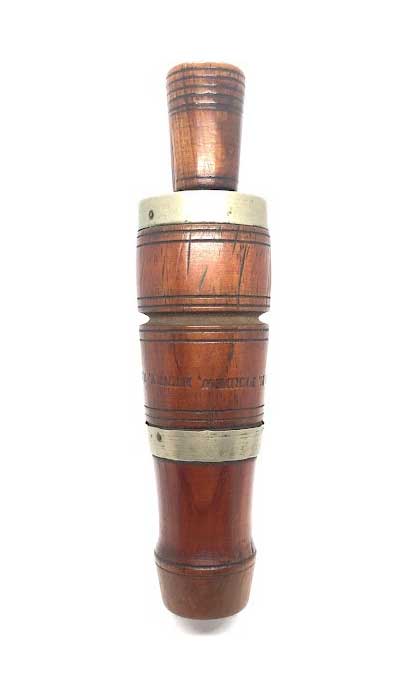
to as his “standard” model.
It has been said that Charlie was a ladies man and couldn’t pass up the pretty housewife that showed up at his door wanting to buy something for their husbands on the spot. Orders that customers had been waiting years for often ended up being bought by these ladies after they flirted and schmoozed up to him. Early on in his career, Charlie made a tandem bicycle that would hold up to three riders. It has been said by those that knew him that every woman in Henry except for Edna got a ride on the bike!
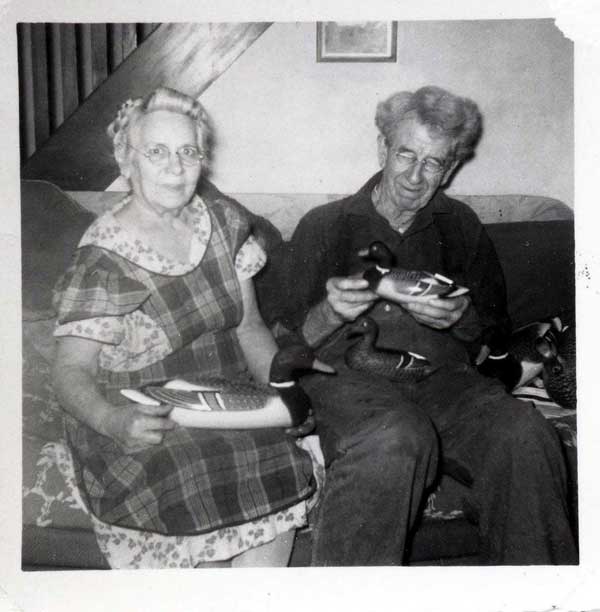
You can see examples of Perdew calls from my collection that are pictured below on display at the Ducks Unlimited Heritage Center in Memphis, Tennessee inside the Bass Pro Shops Pyramid until September 2022. I can be reached at rkegraves@gmail.com and @rkegraves on Instagram.
















